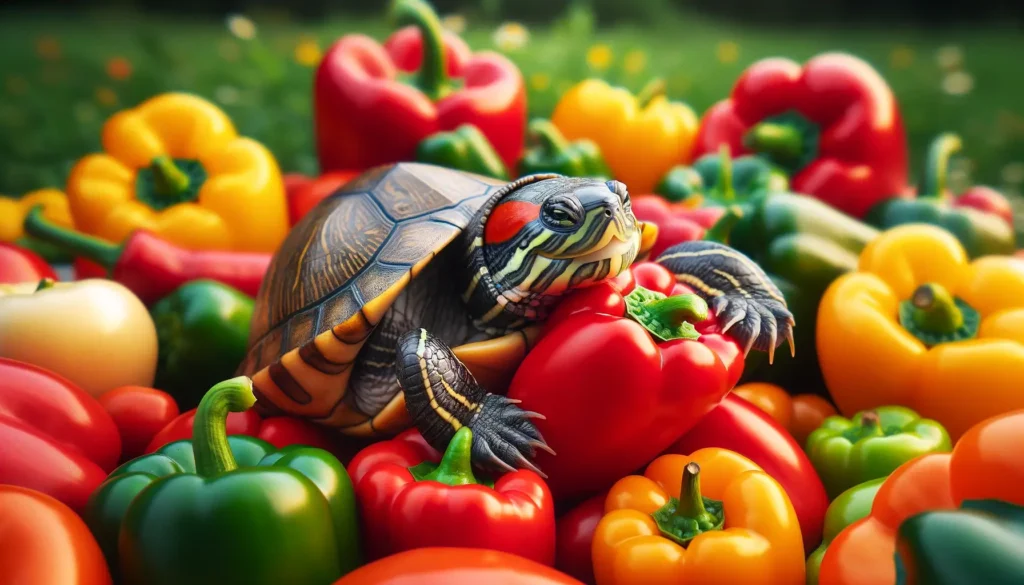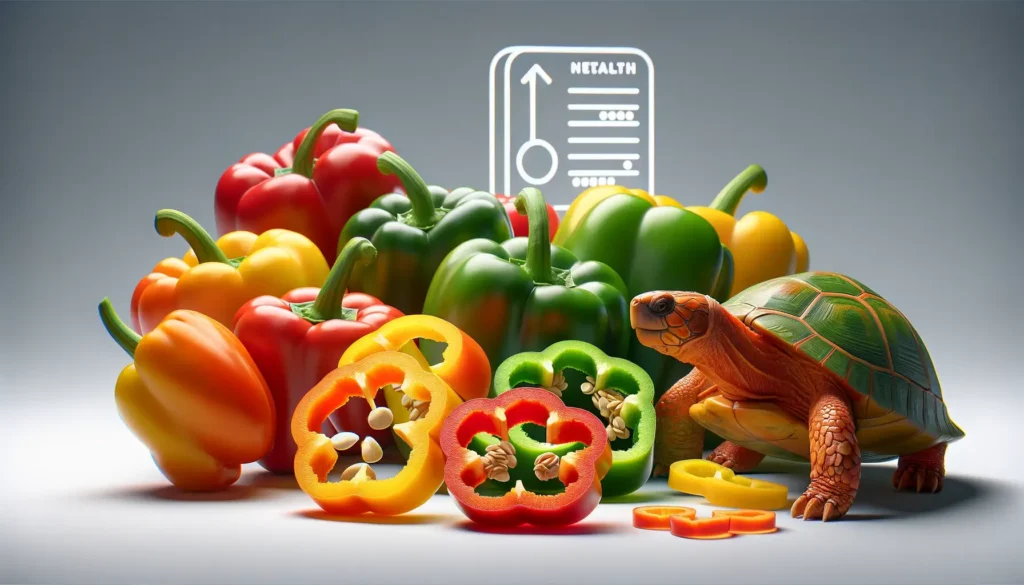Just as you wouldn’t serve your dog a steak dinner every night, it’s essential to understand the unique dietary needs of your pet turtle. You might be wondering if it’s okay to toss a few pieces of bell pepper into your shelled friend’s diet. After all, they’re packed with vitamins and can add a pop of color to an otherwise mundane turtle meal. But is it really safe or even beneficial for a turtle to consume these vibrant veggies? Hold that thought as we’re about to dive into the nitty-gritty of turtle nutrition.

Understanding Turtle Dietary Needs
To fully comprehend whether bell peppers are a safe choice for your turtle’s diet, you first need to grasp the basics of turtle nutrition. Turtles, you see, require a balanced diet that is rich in vitamins, minerals, and proteins. This balance is vital for their growth, health, and overall well-being.
Now, let’s address the question: can turtles eat bell peppers? Bell peppers, whether red or green, are packed with vitamins A and C, both essential to turtle health. However, they should not constitute the majority of their diet.
Can box turtles eat bell peppers? Yes, but moderation is key. Box turtles thrive on a varied diet that includes a mix of vegetables, fruits, and proteins.
What about aquatic turtles? Can aquatic turtles eat bell peppers? Although aquatic turtles are primarily carnivorous, they can safely consume small amounts of bell peppers as a treat.
Bell Peppers: Nutritional Profile
Let’s dive into the nutritional profile of bell peppers better to understand their potential benefits for your turtle’s diet. Bell peppers, particularly the red variety, are rich in several vitamins and minerals. The most prominent of these is Vitamin C, with a single cup providing more than 200% of your daily value. They’re also packed with Vitamin A, crucial for maintaining healthy vision, and Vitamin B6, important for brain development and function.
Beyond vitamins, bell peppers offer a good dose of fiber, which can aid in digestion, and potassium, which supports heart health. They’re also low in calories and fat, which is beneficial for preventing obesity in your pet. Furthermore, bell peppers contain a significant amount of water, which contributes to hydration.

However, it’s worth noting that bell peppers also contain a compound called oxalate. In high amounts, oxalates can contribute to the formation of kidney stones in turtles. Therefore, although bell peppers are nutritionally dense, they should not make up the bulk of your turtle’s diet. Like any food item, moderation is key to ensuring a balanced diet and overall health for your pet.
Benefits of Bell Peppers for Turtles
Feeding your turtle bell peppers can offer a range of health benefits due to their rich vitamin, mineral, and fiber content. These vibrant veggies are packed with vitamins A and C, which contribute to the overall health and wellness of your shelled friend. Vitamin A supports eye health, which is crucial for turtles who rely on their vision for foraging and navigation. Vitamin C, on the other hand, boosts the immune system, helping your turtle resist diseases and infections.
Bell peppers also contain significant amounts of dietary fiber, which aids in digestion and can prevent constipation in turtles. They’re low in calories, too, so they won’t contribute to obesity, a common problem in captive turtles. The mineral content, including calcium and potassium, promotes strong shell and bone development.
Moreover, the vibrant colors of bell peppers can stimulate your turtle’s appetite, making them a useful tool in encouraging picky eaters. However, keep in mind that bell peppers should be fed in moderation alongside a balanced diet, as too much of any food can cause nutritional imbalances.
Potential Risks and Precautions
While bell peppers can undoubtedly benefit your turtle’s health when fed properly, it’s essential also to be aware of potential risks and necessary precautions. Even though they’re non-toxic to turtles, bell peppers should constitute a small fraction of their diet. Overfeeding can lead to health concerns such as Vitamin C overdose, characterized by diarrhea, anorexia, and lethargy.

Additionally, turtles have a slow digestive system, and the high fiber content in bell peppers can cause digestive problems if fed in large quantities. It’s also crucial to note that not all turtles can tolerate the same foods. For example, aquatic turtles may have difficulty processing bell peppers and could suffer from digestion issues.
To prevent these potential risks, it’s recommended to introduce bell peppers gradually into your turtle’s diet and monitor its reaction. Always chop the peppers into small, manageable pieces to reduce the risk of choking. Moreover, remember to wash the peppers thoroughly to remove any pesticides or toxins that could harm your turtle. Lastly, always consult with a vet if you’re unsure about feeding bell peppers to your turtle. Your pet’s health and safety should always be your priority.
Incorporating Bell Peppers into Turtle Diets
How to best incorporate bell peppers into your turtle’s diet without causing any health issues. To do this safely and effectively, you’ll need to consider a few key points.

Firstly, bell peppers should never be the main component of your turtle’s diet. They are best served as occasional treats, making up no more than 10-15% of the diet. This ensures your pet gets a balanced nutritional intake.
Secondly, always ensure the peppers are fresh and thoroughly washed to remove potential pesticides. Dice them into small, manageable pieces for easy consumption.
Thirdly, introduce bell peppers gradually. Start with small portions and observe your turtle’s behavior and stool. If there’s no adverse reaction, you can continue feeding them bell peppers occasionally.
Lastly, consider the color of bell peppers. Red, orange, and yellow peppers are generally sweeter and have a higher content of Vitamin A compared to green ones. However, the nutritional difference is not significant enough to cause concern.

